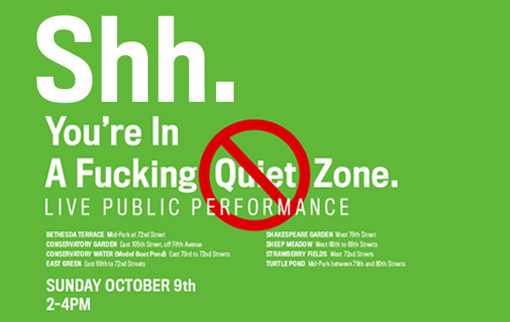Have you heard that musicians in Central Park are now prohibited from playing in EIGHT of the park’s most densely populated areas?
Bethesda Terrace
Conservatory Garden
Conservatory Water
East Green
Shakespeare Garden
Sheep Meadow
Strawberry Fields
Turtle Pond
Translation – NO MUSICAL INSTRUMENTS + NO AMPLIFIED SOUND.
http://www.centralparknyc.org/visit/general-info/faq/
“Park signs are traditionally prohibitive — a lot of ‘Don’t do this, don’t do that,’” said Douglas Blonsky, president of the Central Park Conservancy. “The primary purpose of our new signs is to help visitors have as rich an experience as possible in the park – we’re telling them: ‘Do this! Try this!’”
Do NOTHING! Try SILENCE!
Unacceptable.
Shh. You’re In A Fucking Quiet Zone.
The Public Performs
Sunday, October 9th from 2-4pm
In each of Central Parks 8 ‘Quiet’ Zones
During the performance, musicians, situated in each of the eight Quiet Zones, will play Silence – a musical score that necessitates all the behaviors associated with making music, but falls short of generating sound. Cue public discourse!
Sit down. Shut up. Enjoy!
All are welcome.
In case you’re asking yourself, why? Parks have an inherently political character. “Although planned as places of healthful recreation for all classes, landscape parks [such as Central Park] were built to middle-class standards. This environment of seamless coherence between middle-class behavior and graceful, tastefully furnished landscape would “natually” compel the working-class users to emulate their social betters. If emulation was not forthcoming, widespread supervision and enforcement effectively curtailed unsuitable behavior…The conflicts that sometimes occurred between working-class behavior and middle-class mores resulted in the criminalization of certain forms of behavior.” (Taylor, D. 1999. Central Park as a Model for Social Control: Urban Parks, Social Class, and Leisure Behavior in Nineteenth-Century America. Journal of Leisure Research 31 (4):420-477)
Seven of the eight Quiet Zones in Central Park were delineated in the mid-1980s. Bethesda Terrace was recently amended to the list, when the Central Park Conservancy (a private institution) unveiled its new wayfinding program which includes explicit labeling for all Quiet Zones. “Park signs are traditionally prohibitive — a lot of ‘Don’t do this, don’t do that,’” said Douglas Blonsky, president of the Central Park Conservancy. “The primary purpose of our new signs is to help visitors have as rich an experience as possible in the park – we’re telling them: ‘Do this! Try this!’” http://cityroom.blogs.nytimes.com/2011/08/29/central-park-has-1500-new-ways-to-say-keep-off-or-on-the-grass/
“Central Park is better than ever and has tripled in visitation since the ’80s from 12 million then to over 37 million now,” Parks Department spokeswoman Vickie Karp wrote in an email. “Millions more people, at least a little more enforcement [is] needed.” http://www.dnainfo.com/20110602/upper-east-side/bethesda-terrace-buskers-use-facebook-fight-central-park-quiet-zone
Is the goal to offer quiet repose or more enforcement? And enforcement of what? Currently Title 56.105.D dictates that musicians and performers are restricted from playing music in the most densely populated areas of Central Park. Translation – less exposure and less income.
At one point the powers that be understood the cultural diversity value inherent in musicians and street performers. According to CentralPark.com, “Today, it the Bethesda Terrace is known for its spectacular views, people-watching opportunities, and frequent appearances by talented street performers.” http://www.centralpark.com/guide/attractions/bethesda-terrace.html
Admittedly, I am coming late to the table. But I’m here + prepared to promote the natural soundtrack of Central Park.
you can find us on facebook at:
http://www.facebook.com/event.php?eid=258023287574710
rules of the city of new york title 56
http://24.97.137.100/nyc/RCNY/Title56_1-05.asp?zoom_highlight=Noise%3B+Musical+Instruments%3B+Sound+Reproduction+Devices
